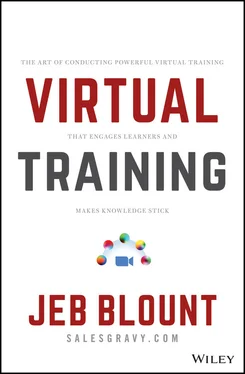3 The Case for Virtual Training
Before I make the case for virtual training, let's acknowledge that dynamic in-classroom training can be a powerful learning experience. This is especially true when it includes collaborative breakout sessions and experiential learning elements delivered by a talented, passionate instructor. For many participants, perhaps, it provides the very best overall experience on an emotional level. Few rational people would argue otherwise.
The problem is that classroom-based, instructor-led training is both expensive and inefficient. First, there is the investment in the actual training:
The trainer
Content licensing (when using a third-party curriculum)
Then there are the expenses for:
Travel and meals
Lost productivity while participants are out of the field and in the classroom
The training space (whether it is a dedicated area in your building, or rented space at a hotel or conference center)
Printed materials (e.g., name tags, tent cards, handouts, and workbooks)
Liability insurance
Indirect environmental costs (e.g., energy consumption, carbon emissions)
More often than not, the investment in the trainer (and licensing, if applicable) is dwarfed by the expenses that aren't directly related to the actual training. We surveyed our clients and found that between 50 and 80 percent of classroom-based, instructor-led training investment is spent on nontraining expenses like travel. With so much money wasted on incidental expenses, in-person training programs make it challenging to get a return on the investment.
These high costs also mean that learning and development (L&D) organizations cannot afford to experiment or make mistakes with physical classroom training. This stifles innovation, agility, and speed when organizations need to change. These incidental costs also put severe limits on the amount of ongoing training that can be delivered by an organization.
The truth is, there will always be a need for in-person classroom instruction for adults. There are some forms of training—for example, how to repair a diesel engine or perform a medical procedure—that require a hands-on learning experience. Yet, even this type of training may be blended and enhanced with e-learning, virtual training, and virtual and augmented reality components to accelerate skill development and mastery.
Of course, you can eliminate most of these costs and rapidly deploy training with asynchronous, self-directed e-learning. Just send learners to your learning management system (LMS) and have them advance through a series of videos, online modules, and assessments.
Most large organizations have made significant investments in LMSs and building out e-learning catalogs. Self-directed e-learning is the hottest segment in L&D, and it's projected to grow to $325 billion globally in the near term. 1
With e-learning, people may consume training content and learn on their own terms anywhere, anytime, on any device. It is a cheap and easy way to train lots of people fast, with little friction. But driving real learning through self-paced e-learning courses has some serious drawbacks, as anyone who's tried it will tell you. The truth is:
When left on their own, most people abandon the training. Studies indicate that more than 90 percent of online learners never complete their courses. 2
E-learning on its own doesn't work well for teaching complex skill sets and competencies.
People learn better when they collaborate with other people.
Don't get me wrong, there are certain subjects such as compliance and technical how-to instruction in which e-learning excels. Even so, because e-learning leads to a “set it and forget it” mentality, leaders and L&D professionals tend to take a hands-off approach to directing and monitoring e-learning activities. This dilutes the potential return that e-learning offers because either learners abandon the coursework or just go through the motions to check off the requirements so that they look good on reports.
I've observed, on many occasions, competent people fail an end-of-course assessment that should be so easy that a cat could pass it. This happens because they click through the content on the LMS like zombies without paying attention, just to check the boxes.
Most humans need more than a set of videos to truly learn and adopt new skills and behaviors. Albert Bandura's social learning theory posits that people learn best in groups where they have the opportunity to observe, emulate, and practice new skills together. 3
People wish to communicate, collaborate, and at times commiserate as they stretch through the process of shifting their mindset and acquiring new skills. Humans long for social engagement and the shared community and experience of a classroom cohort.
Simply put, e-learning is missing that social component, so by itself it is not an effective way to develop competency and drive behavior change.
This is exactly why synchronous classroom-based and virtual instructor-led training is, and will continue to be, an important cornerstone of learning and development initiatives.
Enter Virtual Instructor-Led Training
Virtual instructor-led training (VILT) blends the social learning benefits of classroom-based training with the speed, agility, and cost-effectiveness of e-learning—without the wasted expenses associated with the physical classroom.
This means that organizations are able to deliver more high-quality training and rapidly upskill more people, at a much lower cost, which generates a far higher return on the training investment.
The good news is, for a large swath of curricula, VILT, delivered well, is just as effective as classroom training. Furthermore, because a virtual training curriculum can be chunked into shorter training sessions, it is often superior to classroom training when it comes to making learning stick. Numerous academic studies have proven that humans can better retain and apply learned skills when training is delivered in succinct, easy-to-consume chunks.
Richard E. Mayer's segmenting principle describes how chunking breaks complex curricula and courses into concise virtual sessions. 4 For example, eight hours of physical classroom training might be broken into smaller segments (e.g., eight 1-hour sessions, four 2-hour sessions) with time between each session for practice, homework assignments, and blended e-learning content.
Rather than the firehose-in-the-mouth format that physical classroom training typically requires, VILT redesigns the learning path to work the way humans learn best—in short, sequential chunks of information that layer one lesson upon another and present opportunities for repetition and practice.
Learning outcomes improve further when there is time between these chunks of training for participants to practice new skills in the real world, with supportive instructor coaching. These breaks between training sessions provide a faster feedback loop that accelerates the cognitive process of learning. However, this form of on-the-job experiential learning—learning by doing—is impractical with most classroom-based training (see cost and travel constraints).
Compared with traditional classroom training, the combination of chunking and experiential learning in a VILT environment is often a better investment for organizations. When used together, these two strategies improve the probability that training will stick and the desired behavioral changes will be actualized.
While it is certainly more challenging to re-create the social and collaborative environment of the physical classroom in a virtual setting, VILT more than makes up for this shortcoming in other important ways:
Читать дальше












